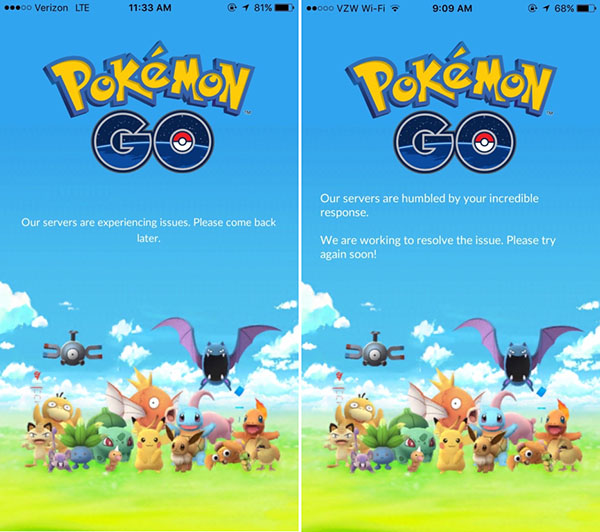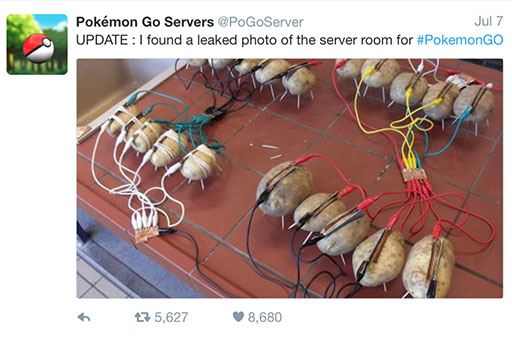This blog post is about the popular augmented reality game, Pokémon GO. If you are unfamiliar and/or want a brief overview of it and its cultural history, this is a useful resource.
As a virtual world anthropologist and a Pokémon nerd, I have become immersed in Pokémon GO. As the game continues to gain traction and I wander around meeting strangers and friends who are also playing the game, I have taken note of numerous issues of anthropological concern, like new forms of social interaction and the re-mapping and flattening of cityscapes. Colleagues and I have even speculated about whether Pokémon GO is a virtual world—by which I mean a computer-simulated, persistent, and shared environment online—and, if it is such a world, how it represents one that is visible even to non-players.
Participating in and observing the Pokémon GO phenomenon, I’ve found that players have been confronted by another recurring topic related to visibility: the visibility of game servers. I recently attended a large gathering of about 1000 Pokémon GO players in downtown Riverside, CA. We all walked around together, yet apart, huddled among small groups of friends with phones in hand, capturing virtual pets. Servers are the typically invisible and distant machines that allow such an event to happen. They connect people to the game world and to one another by receiving and returning signals to and from our mobile devices. They are an integral part of the ecology of media that enables the shared experience of being in a virtual space overlaid upon the actual world—and, curiously, players have a vague understanding of this. Pokémon GO servers have become very visible. If you ask any Pokémon GO player, servers are to blame for some of the greatest downfalls of the game, like faulty connections, glitches, outages, and lag. Developers have repeatedly mentioned servers as the root of many issues with the game, and, as a result, many players continue to point fingers at servers. So why have servers, things we can’t see or even explain, become the targets of so much anger and frustration? How can we characterize the very visible role servers play in the social worlds of Pokémon GO?
The material lives of servers are normally hidden for the average Internet user. We have our own machines to use and care for, and we have a basic understanding that there are some other machines maintained by someone, housed in some place, doing something. As sociologist Susan Leigh Star remarked in her famous call for the closer ethnographic examination of ‘boring things’ like servers: “[Infrastructure] is by definition invisible, part of the background of other kinds of work” (1999, 380). With the rapid and nearly global explosion of Pokémon GO, I think we are seeing an emergence of very real, popular attempts to visualize and represent server infrastructure, to make vague grasps at one of the many strange, yet familiar black boxes in our everyday experiences of digital interconnectedness. I don’t intend to argue that servers are in any way fully responsible for the Pokémon GO craze—there’s no need to give them more credit than they deserve. Nor do I think that these things are incredibly novel or groundbreaking—in fact I know they aren’t. However, with a game this popular, it is impossible to ignore the fact that with increasing visibility of the game comes the increasing visibility of the servers that are meant to “serve.”
Listing the properties of infrastructure, Star wrote that it “becomes visible upon breakdown” (1999, 382). When Pokémon GO servers stop working, whether due to maintenance, overwhelming spikes in active users, or a hacker-led overload of the server (see Jussi Parikka 2015 for a great examination of DDoS attacks), they become visible. People have responded to this shift in distinct ways given their particular relationship to servers.
 The day after the game app was released for iOS and Android, the game was inaccessible for a large portion of the day. The image many people saw within the app was this one, featuring the words, “Our servers are experiencing issues.” Six days later, after many more outages due to servers experiencing their “issues,” the developers changed the text to say, “Our servers are humbled by your incredible response. We are working to resolve the issue.” In the latest text, the servers have remained unreliable and imperfect, yet they are framed as excusable in a very personal way: your response made the servers feel humble. Servers curiously become the name without a face for connective disruption as the developers insist that servers are more human than they are.
The day after the game app was released for iOS and Android, the game was inaccessible for a large portion of the day. The image many people saw within the app was this one, featuring the words, “Our servers are experiencing issues.” Six days later, after many more outages due to servers experiencing their “issues,” the developers changed the text to say, “Our servers are humbled by your incredible response. We are working to resolve the issue.” In the latest text, the servers have remained unreliable and imperfect, yet they are framed as excusable in a very personal way: your response made the servers feel humble. Servers curiously become the name without a face for connective disruption as the developers insist that servers are more human than they are.
It then falls upon players to imagine the visages of these faceless and humbled machines. As the game was released and users encountered the lack of access and the error screens above, social media platforms saw posts creatively and humorously imagining Pokémon GO servers as potatoes. For example, the Twitter account @PoGoServer posted an image of a table covered in potatoes cabled together with electrodes. The image quickly spread, ending up on the KnowYourMeme website, beside other uses of potatoes as odd pejorative insults. This of course is a reference to the ability of a potato to conduct electricity, but it also says something about the way we trust digital infrastructure to work.
So why have players compared servers to potatoes, while developers humanize them? The personification of technology is nothing new, but it is a different thing altogether to personify something like a server, a mechanical piece of infrastructure locked away in a cold data center somewhere. We don’t personify other forms of infrastructure like roads or highways, sewers or electric plants. No, when those malfunction, we turn to other authoritative subjects: engineers, developers, politicians, “the government.” Perhaps, then, visible servers represent the face of a kind of power, a controlling authority that we have come to hold responsible for issues with access and interconnection. But are they really always to blame?
We don’t think about servers when they are doing what they are meant to do; they remain buried in our minds. However, as soon as they malfunction, they have to come to the surface, whether as human or potato. Nicole Starosielski (2015) has written of undersea fiber optic cables, core components of our global Internet infrastructure, “surfacing” from the ocean, in a very tangible, visible sense. Servers, as parts of that diverse infrastructure, surface in other ways. In many virtual worlds, for instance, servers represent copies of the same virtual space, carrying their own names, populations, and identities. In my own dissertation work on virtual worlds and queer communities, I have found that servers surface as distinct places that in some cases have these kind of imagined boundaries, allowing queer players to find and build safe spaces. These examples suggest that servers are perceived not just as mechanical objects that perform distant, robotic tasks. They are also seen as idiosyncratic and variable, receiving quite a lot of blame for so many of our technological shortcomings. Or perhaps it is that they have become a convenient scapegoat for other more hidden issues at hand, like labor, energy, and capital. Do servers have the potential to make these background forces more visible?
References
Parikka, Jussi. 2015. “Denials of Service.” In There is no Software, there are just Services, edited by Irina Kaldrack and Martina Leeker, 103-111. Leuphana University of Lüneberg: meson press.
Star, Susan Leigh. 1999. “The ethnography of infrastructure.” American Behavioral Scientist 43:377 – 391.
Starosielski, Nicole. 2015. The Undersea Network: Duke University Press.


1 Trackback